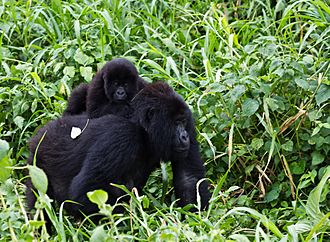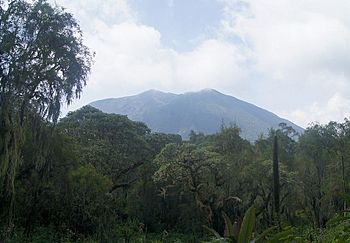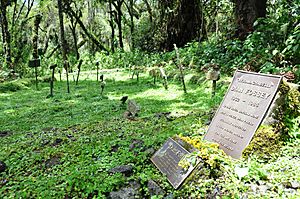Dian Fossey facts for kids
Quick facts for kids
Dian Fossey
|
|
|---|---|
 |
|
| Born | January 16, 1932 San Francisco, California, U.S.
|
| Died | c. December 26, 1985 (aged 53) Volcanoes National Park, Rwanda
|
| Cause of death | Murder |
| Resting place | Karisoke Research Center |
| Alma mater | |
| Known for | Study and conservation of the mountain gorilla |
| Scientific career | |
| Fields | |
| Institutions |
|
| Thesis | The behaviour of the mountain gorilla (1976) |
| Doctoral advisor | Robert Hinde |
| Influences |
|
Dian Fossey ( DY-an; January 16, 1932 – c. December 26, 1985) was an American primatologist and conservationist. She studied mountain gorilla groups from 1966 until her murder in 1985. She studied them daily in the mountain forests of Rwanda.
Fossey spent 20 years in Rwanda, where she supported conservation efforts, strongly opposed poaching and tourism in wildlife habitats, and made more people acknowledge the sapience of gorillas. She was murdered in her cabin at a remote camp in Rwanda in December 1985. Her research and conservation work helped reduce the downward population trend in mountain gorillas.
Contents
Early life
Fossey was born in San Francisco, California. She was the daughter of Hazel (née Kidd), a fashion model, and George Edward Fossey III, a real estate agent and business owner. Her parents divorced when she was six. Her mother remarried the following year, to businessman Richard Price. Her father tried to keep in contact, but her mother discouraged it, and all contact was subsequently lost.
Fossey's stepfather, Richard Price, never treated her as his own child. He would not allow Fossey to sit at the dining room table with him or her mother during dinner. Struggling with personal insecurity, Fossey turned to animals as a way to gain acceptance. Her love for animals began with her first pet goldfish and continued throughout her entire life. At age six, she began riding horses, earning a letter from her school; by her graduation in 1954, Fossey had established herself as an equestrienne.
Education and medical career
Fossey attended Lowell High School. Following the guidance of her stepfather, she enrolled in a business course at the College of Marin in San Francisco. However, spending her summer on a ranch in Montana at age 19 rekindled her love of animals, and she enrolled in a pre-veterinary course in biology at the University of California, Davis.
Fossey decided to spend her professional life working with animals. Her parents failed to support her financially. She supported herself by working as a clerk at a White Front department store, doing other clerking and laboratory work, and laboring as a machinist in a factory.
Although Fossey had always been an exemplary student, she had difficulties with basic sciences including chemistry and physics, and failed her second year of the program. She transferred to San Jose State College, where she became a member of Kappa Alpha Theta sorority, to study occupational therapy. She received her bachelor's degree in 1954.
Fossey began a career in occupational therapy. She interned at various hospitals in California and worked with tuberculosis patients. Fossey was originally a prizewinning equestrian, which drew her to Kentucky in 1955, and a year later took a job as an occupational therapist at the Kosair Crippled Children's Hospital in Louisville.
Her shy and reserved personality allowed her to work well with the children at the hospital. Fossey became close with her coworker Mary White "Gaynee" Henry, secretary to the hospital's chief administrator and the wife of one of the doctors, Michael J. Henry. The Henrys invited Fossey to join them on their family farm, where she worked with livestock on a daily basis and also experienced an inclusive family atmosphere that had been missing for most of her life. During her free time she would pursue her love of horses.
Journey to Africa
Fossey turned down an offer to join the Henrys on an African tour due to lack of finances, but in 1963 she borrowed $8,000 (one year's salary), took out her life savings and went on a seven-week visit to Africa. In September 1963, she arrived in Nairobi, Kenya.
Her safari guide, John Alexander, accompanied her for the next seven weeks through Kenya, Tanzania, Democratic Republic of Congo, and Rhodesia, now Zimbabwe. The final two sites for her visit were Olduvai Gorge in Tanzania (the archeological site of Louis and Mary Leakey); and Mt. Mikeno in Congo, where, in 1959, American zoologist George Schaller had carried out a yearlong pioneering study of the mountain gorilla. At Olduvai Gorge, a friend told her about the work of English primatologist Jane Goodall and the importance of long-term research on the great apes.
Two Kenyan wildlife photographers Joan and Alan Root allowed Fossey and Alexander to camp behind their own camp. It was during these few days that Fossey first encountered wild mountain gorillas. After staying with friends in Rhodesia, Fossey returned home to Louisville to repay her loans. She published three articles in The Courier-Journal newspaper, detailing her visit to Africa.
Research in the Congo
Three years after the original safari, Fossey was invited to undertake a long-term study of the gorillas in the same manner as Jane Goodall had with chimpanzees in Tanzania.
After studying Swahili and auditing a class on primatology during the eight months it took to get her visa and funding, Fossey arrived in Nairobi in December 1966. On the way to the Congo, Fossey visited the Gombe Stream Research Centre to meet Goodall and observe her research methods with chimpanzees.
Fossey began her field study at Kabara, in the Congo in early 1967. Fossey identified three distinct groups in her study area, but could not get close to them. She eventually found that mimicking their actions and making grunting sounds assured them, together with submissive behavior and eating of the local celery plant.
Fossey had arrived in the Congo in locally turbulent times. On July 9, 1967, soldiers arrived at the camp to escort Fossey and her research workers down, and she was detained at Rumangabo for two weeks. Fossey eventually escaped through bribery. She was advised by the Ugandan authorities not to return to Congo and decided to continue her study in Rwanda.
Conservation work in Rwanda
On September 24, 1967, Fossey founded the Karisoke Research Center, a remote rainforest camp nestled in Ruhengeri province in the saddle of two volcanoes. Established 3,000 metres (9,800 ft) up Mount Bisoke, the defined study area covered 25 square kilometres (9.7 sq mi). She became known by locals as Nyirmachabelli, or Nyiramacibiri, roughly translated as "The woman who lives alone on the mountain."
Unlike the gorillas from the Congo side of the Virungas, the Karisoke area gorillas knew humans only as poachers, and it took longer for Fossey to be able to study the Karisoke gorillas at a close distance. Fossey attempted to habituate the gorillas by copying their actions. Over time the gorillas became accustomed to Fossey. As she explained to the BBC in 1984: "I'm an inhibited persona and I felt that the gorillas were somewhat inhibited as well, so I imitated their natural, normal behaviour like feeding, munching on celery stalks or scratching myself."
Fossey made discoveries about gorillas including how females transfer from group to group over the decades, gorilla vocalization, hierarchies nd social relationships among groups, gorilla diet, and how gorillas recycle nutrients. Fossey's research was funded by the Wilkie Foundation and the Leakey Home, with primary funding from the National Geographic Society.
In 1970, she appeared on the cover of National Geographic Magazine, which brought tremendous attention to her work.
Fossey was often hostile to Africans who entered into the protected area, even shooting roaming cattle.
By 1980, Fossey, who had obtained her PhD at Cambridge University in the UK, was recognized as the world's leading authority on the physiology and behavior of mountain gorillas, defining gorillas as being "dignified, highly social, gentle giants, with individual personalities, and strong family relationships." Fossey lectured as professor at Cornell University in 1981–83.
Many research students left after not being able to cope with the cold, dark, and extremely muddy conditions around Karisoke on the slopes of the Virunga Volcanoes, where paths usually had to be cut through six-foot-tall grass with a machete.
Death
In the early morning of December 27, 1985, Fossey was discovered dead in the bedroom of her cabin located at the far edge of the camp in the Virunga Mountains, Rwanda. The cabin was littered with broken glass and overturned furniture. Her cabin had been ransacked. However, robbery was evidently not the motive for the crime, as Fossey's valuables were still in the cabin, including her passport, handguns, and thousands of dollars in U.S. bills and traveler's checks.
The last entry in her diary read:
When you realize the value of all life, you dwell less on what is past and concentrate more on the preservation of the future.
Fossey is buried at Karisoke, in a site that she herself had constructed for her deceased gorilla friends. She was buried in the gorilla graveyard next to Digit, and near many gorillas killed by poachers. Memorial services were also held in New York City, Washington, D.C., and California.
Personal life
Fossey was never married and had no children, but she had relationships throughout the years and always had a love for children.
Dian Fossey quotes
- “When you realize the value of all life, you dwell less on what is past and concentrate more on the preservation of the future.”
- “The man who kills the animals today is the man who kills the people who get in his way tomorrow.”
Interesting facts about Dian Fossey
- She graduated with a Doctor of Philosophy in Zoology in 1976.
- Fossey had been plagued by lung problems from an early age.
- She was a heavy smoker and suffered from advanced emphysema.
- Fossey held Christmas parties every year for her researchers, staffers, and their families.
- She developed a genuine friendship with Jane Goodall.
- Fossey would rescue any abused or abandoned animal she saw in Africa or near Karisoke.
- Many animals lived in her cabin, including a monkey, Kima, and a dog, Cindy.
- Fossey strongly opposed wildlife tourism, as gorillas are susceptible to human anthroponotic diseases like influenza from which they have limited immunity. Interestingly, Fossey's research, and the following publicity, spawned "gorilla tourism".
- In 2014, the 82nd anniversary of Fossey's birth was commemorated by a Google Doodle.
- After her death, Fossey's Digit Fund in the US was renamed the Dian Fossey Gorilla Fund International.
- The Karisoke Research Center is operated by the Dian Fossey Gorilla Fund International, and continues the daily gorilla monitoring and protection that she started.
- Gorillas in the Mist, a book published two years before her death, is Fossey's account of her scientific study of the gorillas at Karisoke Research Center and prior career. It was adapted into a 1988 film of the same name.
- Gorillas in the Mist was praised by Nikolaas Tinbergen, the Dutch ethologist and ornithologist who won the 1973 Nobel Prize in Physiology or Medicine. Her book remains the best-selling book about gorillas.
- In December 2017, Dian Fossey: Secrets in the Mist, a three-hour series, aired on the National Geographic Channel. The series tells the story of Fossey's life, work, murder and legacy, using archive footage and still images, interviews with people who knew and worked with her, specially shot footage, and reconstruction.
See also
 In Spanish: Dian Fossey para niños
In Spanish: Dian Fossey para niños





